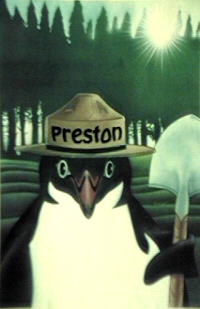"Only you can prevent software piracy!"
A major issue in the early 80's was software piracy. Publishing computer software for a large market was a new idea. Software was easily copied from one disk to another. The people forming businesses to produce computer software were dependent on sales to survive. But there was no cultural inhibition to copying computer programs. People spent a couple thousand dollars to buy a computer and they didn't necessarily want to spend a heck of a lot more to get it to do something.
The result was that almost all software was "copy-protected". The disk was written in some way so that you couldn't just copy the contents from one disk to another. (This was, remember, before hard disks for PCs and installation software.) So you had to have the original disk from the manufacturer to use the program. Other companies sprouted with products designed to copy "protected" disks, and it eventually became a big game... new forms of copy protection to foil the copy programs, repeated into infinity.
Our first publication, The Complete Graphics System, originally was copy-protected (in a devious way*) as was most software. But it was kind of bothersome, since we were taught to "always make back-up copies of anything important". Disks occasionally had problems, and it seemed a terrible inconvenience for someone who was using CGS if suddenly their disk wouldn't work, and then they have to send it back and wait a week or so with their project for a new disk (standard procedure at the time).
So a decision was made that would alter the way software was published in the 80's. Others in the industry, such as Al Tommervik, publisher of Softalk magazine, thought the idea was crazy. "You've got a successful company started, and you'll throw it all away!"
A letter was sent and printed in all the computer publications of the time. One magazine likened the situation to Destry facing an entire band of outlaws without a gun. We would no longer copy-protect our applications software. "Please make backup copies for your personal use, but don't betray our trust by making copies for others." Our other publisher friends basically said "it was nice knowing you..."
 So
the copy protection was removed.... and.... sales increased! At trade shows, seldom did
more than a minute or two pass without someone coming up to our booth stating "I've copied
all kinds of software, but I'll never copy anything of yours! Thank you for giving us software
we can really use!" No, the company did
not sink, and sales did not diminish. Instead, the unprotected Complete Graphics
System, Special Effects, and The Graphics Magician jumped to the
top of the charts and stayed there for years. Other companies observed, and eventually
they removed their copy-protection.
So
the copy protection was removed.... and.... sales increased! At trade shows, seldom did
more than a minute or two pass without someone coming up to our booth stating "I've copied
all kinds of software, but I'll never copy anything of yours! Thank you for giving us software
we can really use!" No, the company did
not sink, and sales did not diminish. Instead, the unprotected Complete Graphics
System, Special Effects, and The Graphics Magician jumped to the
top of the charts and stayed there for years. Other companies observed, and eventually
they removed their copy-protection.
(That's Steve Wozniak's son wearing a Preston "Only you can prevent software piracy" t-shirt.)

* We can probably safely break the silence now: Most copy protection involved modifying the DOS so that the tracks and sectors of the disk itself were written and read in a non-standard manner, and that's the turf on which the back and forth game between copy-protection and breaking copy-protection was being waged.
We went a different direction. Consumer floppy disks had a notch in the corner that the disk drives recognized as meaning "I can write to this disk". Covering the notch with a sticker that came with it told the disk drive that the disk should NOT be written to. That was one way for people to avoid mistakenly overwriting information they wanted to keep. Most software manufacturers bought unnotched disks in bulk so that consumers couldn't accidentally erase their purchased software. We had to modify our production drives to ignore the notchless disks so we could write to them in the first place.
Our "copy protection" was a boot-up sequence that simply attempted to write something to a safe place on the disk. If an "error" came back, we concluded that it must be our notchless production disk and thus it was not a pirated copy and it ran just fine. But when someone copied our software to a notched consumer disk, the attempted write would be successful, so we concluded it was an unauthorized copy and we stopped the boot-up sequence. Our early disks could actually be copied with any standard copy program. People using Locksmith and other anti-copy-protection software couldn't get it to work. But all it really took was to put the sticker over the notch so the disk drive recognized it as unwritable.



